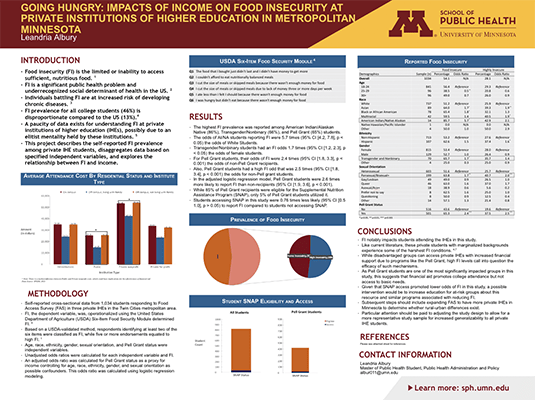Leandria Albury
MPH, Public Health Administration & Policy
Advisor:
Lynn Blewett
Keywords:
Food insecurity; higher education
Abstract
Introduction: Food insecurity (FI) disproportionately affects college students compared to the US population. However, a paucity of data exists for understanding FI at private institutions of higher education (IHEs). This project describes the self-reported FI prevalence among private IHE students and explores the relationship between FI and income.
Methods: We analyzed a Food Access Survey (FAS), a cross-sectional study of students from three private IHEs in metropolitan Minnesota. Survey questions based on the United States Department of Agriculture’s (USDA) Six-Item Food Security Module determined FI for each respondent. Respondents identifying at least two of the six items were classified as FI, while five or more endorsements equated to high FI. The relationship between self-reported FI and income was defined using logistic regression modeling (LRM).
Results: 1,034 student responses were analyzed. 54% reported FI, while 28% reported high FI. The highest FI prevalence was reported among American Indian/Alaskan Native (86%), Transgender/Nonbinary (66%), and Pell Grant (65%) students. Controlling for race, gender, sexual orientation, and ethnicity, Pell Grant recipients were 2.6 times more likely to report FI than non-recipients (95% CI [1.9, 3.58], p < 0.0001). Only 5% of Pell Grant recipients accessed the Supplemental Nutrition Assistance Program (SNAP).
Discussion: The reported prevalence for private IHEs in metropolitan was much higher than the US prevalence (13%). Students receiving financial assistance had a higher FI odds ratio, suggesting that aid supports IHE access, not sustainable living. Therefore, financial assistance programs should be evaluated for their efficacy in adequately supporting private IHE students.

View Poster (PDF)
